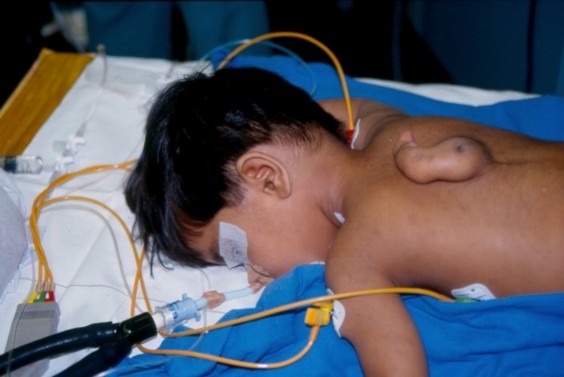Estimated incidence less than 1/106 births. It appears to be more common in Indian and South African populations. Minimal form of conjoined twins (see this term) where most of one of the twins has involuted and presents as an external or internal outgrowth. Sometimes called parasitic twin or ex-fetal fetus (not to be confused with fetus in foetu, which is a form of teratoma).
The parasite can present as a supernumerary limb, an oropharyngeal mass, an abdominal mass, a caudal duplication etc ... The most common forms are rachipagus (42 %) or omphalopagus (38 %).
The normal newborn may present with a cardiac malformation, an omphalocele or a spinal malformation (myelomeningocele, tethered spinal cord).

Anesthetic implications:
echocardiography; according to the localization of the parasite limb. Risk of important hemorrhage. One case of resistance to usual doses of propofol and midazolam was attributed to a change in their volume of distribution by musculoskeletal outgrowth.
References :
- Surendran N, Mani Nainan K, Paulose MO.
An unusual case of caudal duplication.
J Pediatr Surg 1986; 21: 924-5
- Chadha R, Bagga D, Dhar A, Malhotra CJ, Taneja SB.
Epigastric heteropagus.
J Pediatr Surg 1993; 28: 723-7
- Sharma G, Nazarian Mobin SS, Lypka M, Urata M.
Heteropagus (parasitic twins: a review.
J Pediatr Surg 2010; 45: 2454-63.
- Singh B, Sarin A, Choudhary SR.
Anaesthetic considerations in the management of heteropagus twins.
Pediatr Anesth 2004; 14: 191-2.
- Mathur P, Sharma S, Mittal P, Yadav RK, Barolia D.
Heteropagus twins: six cases with systematic review and embryological insights.
Pediatr Surg Int 2022; 28:963-83
- Mathur P, Sharma S, Mittal P, Yadav RK, Barolia D.
Heteropagus twins: six cases with systematic review and embryological insights.
Pediatr Surg Int 2022; 28:963-83
- Singla D, Anija A, Parag Aneja P, Singh S.
Unusual resistance to intravenous anesthetic drugs in a rachipagus infant: a case report.
A&A Practice 2024;18:e01866.
Updated: December 2024